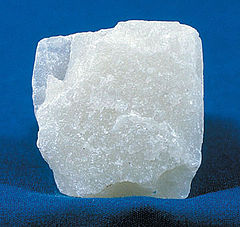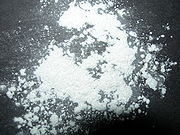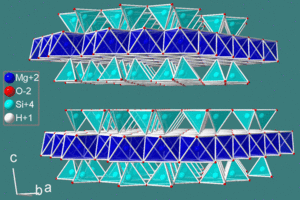
Talc
Background to the schools Wikipedia
This wikipedia selection has been chosen by volunteers helping SOS Children from Wikipedia for this Wikipedia Selection for schools. SOS Children is the world's largest charity giving orphaned and abandoned children the chance of family life.
| Talc | |
|---|---|
 A block of talc |
|
| General | |
| Category | Silicate mineral |
| Formula (repeating unit) |
Mg3Si4O10(OH)2 |
| Identification | |
| Colour | white, grey, green, blue, or silver |
| Crystal habit | foliated to fibrous masses |
| Crystal system | monoclinic or triclinic |
| Cleavage | perfect basal cleavage |
| Fracture | flat surfaces (not cleavage), fracture in an uneven pattern |
| Tenacity | sectile |
| Mohs scale hardness | 1 (defining mineral) |
| Luster | waxlike or pearly, sometimes smooth |
| Streak | white to very pearly green |
| Diaphaneity | translucent |
| Specific gravity | 2.58 to 2.83 |
| Optical properties | biaxial (-) |
| Refractive index | nα = 1.538 - 1.550 nβ = 1.589 - 1.594 nγ = 1.589 - 1.600 |
| Birefringence | δ = 0.051 |
| Pleochroism | weak in dark varieties |
| Other characteristics | fluorescent, non-magnetic, non-radioactive |
| References | |
Talc (derived from the Persian tālk (تالک ) via Arabic talk (تلك)) is a mineral composed of hydrated magnesium silicate with the chemical formula H2Mg3(SiO3)4 or Mg3Si4O10(OH)2. In loose form, it is the widely-used substance known as talcum powder. It occurs as foliated to fibrous masses, its monoclinic crystals being so rare as to be almost unknown. It has a perfect basal cleavage, and the folia are non- elastic, although slightly flexible. It is very soft and sectile (can be cut with a knife); as the defining mineral for the value of 1 on Mohs hardness, it can be easily scratched by a fingernail. It has a specific gravity of 2.5–2.8, a clear or dusty luster, and is translucent to opaque. Talc is not soluble in water, but it is slightly soluble in dilute mineral acids. Its colour ranges from white to grey or green and it has a distinctly greasy feel. Its streak is white.
Soapstone is a metamorphic rock composed predominantly of talc.
Formation
Talc is a metamorphic mineral resulting from the metamorphism of magnesian minerals such as serpentine, pyroxene, amphibole, olivine, in the presence of carbon dioxide and water. This is known as talc carbonation or steatization and produces a suite of rocks known as talc carbonates.
Talc is primarily formed via hydration and carbonation of serpentine, via the following reaction;
- serpentine + carbon dioxide → talc + magnesite + water
- 2Mg3Si2O5(OH)4 + 3CO2 → Mg3Si4O10(OH)2 + 3 MgCO3 + 3 H2O
Talc can also be formed via a reaction between dolomite and silica, which is typical of skarnification of dolomites via silica-flooding in contact metamorphic aureoles;
- dolomite + silica + water → talc + calcite + carbon dioxide
- 3CaMg(CO3)2 + 4 SiO2 + H2O → Mg3Si4O10(OH)2 + 3 CaCO3 + 3 CO2
Talc can also be formed from magnesian chlorite and quartz in blueschist and eclogite metamorphism via the following metamorphic reaction:
- chlorite + quartz → kyanite + talc + water
In this reaction, the ratio of talc and kyanite is dependent on aluminium content with more aluminous rocks favoring production of kyanite. This is typically associated with high-pressure, low-temperature minerals such as phengite, garnet, glaucophane within the lower blueschist facies. Such rocks are typically white, friable, and fibrous, and are known as whiteschist.
Talc is a tri-octahedral layered mineral; its structure is similar to that of pyrophyllite, but with magnesium in the octahedral sites of the composite layers.
Occurrence
Talc is a common metamorphic mineral in metamorphic belts which contain ultramafic rocks, such as soapstone (a high-talc rock), and within whiteschist and blueschist metamorphic terranes. Prime examples of whiteschists include the Franciscan Metamorphic Belt of the western United States, the western European Alps especially in Italy, certain areas of the Musgrave Block, and some collisional orogens such as the Himalayas which stretches along India, Nepal and Pakistan. Talc carbonated ultramafics are typical of many areas of the Archaean cratons, notably the komatiite belts of the Yilgarn Craton in Western Australia. Talc-carbonate ultramafics are also known from the Lachlan Fold Belt, eastern Australia, from Brazil, the Guiana Shield, and from the ophiolite belts of Turkey, Oman and the Middle East.
Notable economic talc occurrences include the Mount Seabrook talc mine, Western Australia, formed upon a polydeformed, layered ultramafic intrusion. The France-based Luzenac Group is the world's largest supplier of mined talc; its largest talc mine at Trimouns near Luzenac in southern France produces 400,000 tonnes of talc per year, representing 8% of world production.
Uses
Talc is used in many industries such as paper making, plastic, paint and coatings, rubber, food, electric cable, pharmaceuticals, cosmetics, ceramics, etc. A coarse grayish-green high-talc rock is soapstone or steatite and has been used for stoves, sinks, electrical switchboards, crayons, soap, etc. It is often used for surfaces of lab counter tops and electrical switchboards because of its resistance to heat, electricity and acids. Talc finds use as a cosmetic (talcum powder), as a lubricant, and as a filler in paper manufacture. Talc is used in baby powder, an astringent powder used for preventing rashes on the area covered by a diaper (see diaper rash). It is also often used in basketball to keep a player's hands dry. Most tailor's chalk is talc, as is the chalk often used for welding or metalworking.
Talc is also used as food additive or in pharmaceutical products as a glidant. In medicine talc is used as a pleurodesis agent to prevent recurrent pleural effusion or pneumothorax. In the European Union the additive number is E553b.
Talc is widely used in the ceramics industry in both bodies and glazes. In low-fire artware bodies it imparts whiteness and increases thermal expansion to resist crazing. In stonewares, small percentages of talc are used to flux the body and therefore improve strength and vitrification. It is a source of MgO flux in high temperature glazes (to control melting temperature). It is also employed as a matting agent in earthenware glazes and can be used to produce magnesia mattes at high temperatures.
ISO standard for quality (ISO 3262)
| Type | Talc content min. wt% | Loss on ignition at 1000 °C, wt % | Solubility in HCl, max. wt % |
|---|---|---|---|
| A | 95 | 4 – 6.5 | 5 |
| B | 90 | 4 – 9 | 10 |
| C | 70 | 4 – 18 | 30 |
| D | 50 | 4 – 27 | 30 |
Patents are pending on the use of magnesium silicate as a cement substitute. Its production requirements are less energy-intensive than ordinary Portland cement at around 650 °C, while it absorbs far more carbon dioxide as it hardens. This results in a negative carbon footprint overall, as the cement removes 0.6 tonnes of CO2 per tonne used. This contrasts with a carbon footprint of 0.4 tonne per tonne of conventional cement.
It is used as an additive for heroin, to expand volume and weight and thereby increase its street value. With intravenous use, it may lead to talcosis, a granulomatous inflammation in the lungs.
Safety
Talc powder is a household item, sold globally for use in personal hygiene and cosmetics and used by many millions every year. Some suspicions have been raised about the possibility its use promotes certain types of diseases, mainly cancers of the ovaries and lungs. This is not widely recognised as an established link.
The studies reference, by subject: pulmonary issues, lung cancer, skin cancer and ovarian cancer. One of these, published in 1993, was a US National Toxicology Program report, which found that cosmetic grade talc containing no asbestos-like fibres was correlated with tumour formation in rats ( animal testing) forced to inhale talc for 6 hours a day, five days a week over at least 113 weeks. A 1971 paper found particles of talc embedded in 75% of the ovarian tumors studied.
The U.S. Food and Drug Administration (FDA) considers talc (Magnesium Silicate) to be generally recognized as safe (GRAS) for use as an anti-caking agent in table salt in concentrations smaller than 2%.





